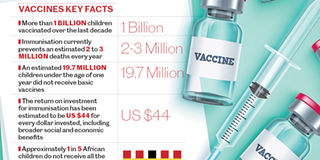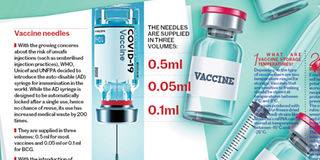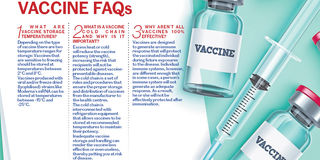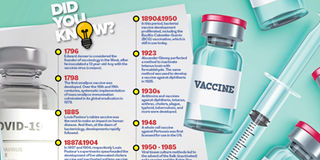Breaking News: Former Lugari MP Cyrus Jirongo dies in a road crash
A-Z of vaccines

What you need to know:
- Eradicated diseases: Smallpox: In 1980, the World Health Assembly endorsed a statement declaring smallpox eradicated.
- Guinea worm: Disease is likely on the verge of eradication.
- Rinderpest: A disease that affected livestock, has also been eradicated.
- Six additional diseases: Lymphatic filariasis (Elephantiasis), polio, measles, mumps, rubella, and pork tapeworm have been named by the Carter Center International Task Force for Disease Eradication as potentially eradicable.
The story of vaccines begins with the long history of infectious diseases in humans and, in particular, with the early use of smallpox material to provide immunity against the disease.
For more than 200 years, vaccines have protected humanity against diseases that threaten lives and hinder development including polio, measles, diphtheria, pertussis (whooping cough), rubella (German measles), mumps, tetanus, rotavirus and Haemophilus influenzae type b (Hib).

Today, the same germs exist, but because babies are protected by vaccines, we do not see these diseases nearly as often as we did.
“While vaccines are not a silver bullet, they will help us progress on a path to a world where we can be together again,” says the World Health Organization (WHO).
What is a vaccine? A vaccine is a type of medicine that trains the body’s immune system so that it can fight a disease it has not come into contact with before.

Vaccine development again hit the headlines in 2020 after the fast launch of two candidates to protect against Sars-CoV-2 which causes Covid-19.
Last week we marked World Immunisation Week – celebrated every year in the last week of April.
It aims to promote the use of vaccines to protect people of all ages against disease. This year’s theme was ‘Vaccines bring us closer’.

What is the difference between vaccination and immunisation?
Vaccination: The act of introducing a vaccine into the body to produce immunity to a specific disease.
Immunisation: A process by which a person becomes protected against a disease through vaccination.

Where should a vaccine be injected?
Most vaccines are given as injections deep into the muscles (intramuscular) of the deltoid (a thick, triangular shoulder muscle) or the anterolateral aspect of the thigh. This optimises the immunogenicity of the vaccine and minimises adverse reactions at the injection site.
Incorrect injection techniques or erroneous injection locations, can cause blood vessel breakage, muscle or nerve damage and paralysis.



